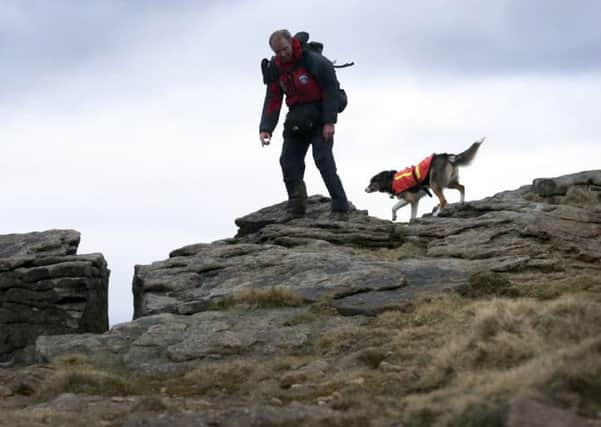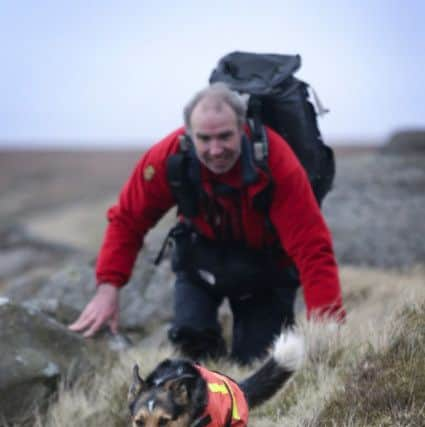Four-legged help for Peak District rescue teams


Founded after a series of tragedies in the 1960s in the sweeping uplands of the world’s second busiest national park, the Peak District Mountain Rescue Organisation (PDMRO) now helps hundreds of people a year.
And to mark its fiftieth anniversary the rescue service carried out a training exercise led by one of its newest recruits - a two-year-old Border Collie named KT.
Advertisement
Hide AdAdvertisement
Hide AdThe use of search and rescue dogs to track down missing people in the Peaks is becoming increasingly common at PDMRO, whose seven teams are made up of unpaid volunteers.


KT, who is still in training with Kinder Mountain Rescue team and is still a year away from becoming fully qualified, this week went out to find three ‘missing’ walkers lost in gale force winds on Kinder Plateau.
Her handler, Ian Burley, 49, said: “She’s showing lots of potential. She’s very keen. She’s already passed the first stage of her training and has another three assessments to pass before she can help us on real call-outs.
“She’s a ‘free-range-scenting dog’ and is learning to identify and locate the smell of any humans.
Advertisement
Hide AdAdvertisement
Hide Ad“It’s important we go ahead of the rest of the rescue team so their smells don’t throw the dog off the scent of the victims.
“She found all three of today’s ‘casualties’ and guided me to them, well before the rest of the team arrived. Air scenting is very wind dependent - but it’s not unheard of to get a strike from 500 metres.”
Howard Taylor, leader of the Kinder mountain rescue team, said dogs were more effective than people on many missing person searches, adding: “It doesn’t matter whether it is night or day or whether it is misty because they use their noses and not their eyes.”
Each of the PDMRO’s seven teams has between 40 and 50 volunteers ready to respond to any incident in any weather.
Advertisement
Hide AdAdvertisement
Hide AdTheir work usually stays within the Peak District National Park but in the past they have assisted in the search for bodies after the Lockerbie plane crash in 1988 and in the hunt for murdered Welsh schoolgirl April Jones.
Mr Taylor said: “Last year we had 46 call outs for Kinder and we are one of the quieter teams.
“We go to climbing accidents, missing walkers, even people with Alzheimer’s who have wandered out of their nursing homes, we have searched for them in the past.
“We are busier now than we have ever been before. There are even more visitors using the Peak District, it is the second busiest national park in the world.
Advertisement
Hide AdAdvertisement
Hide Ad“We are surrounded by centres of population, all within easy driving distance to get there. Technology has moved on and we are a lot more hi-tech and professional than we used to be.”
The organisation coordinates seven civilian groups stretching from Edale on the Sheffield border of the vast national park all the way down to Derby.
Each team is a self-contained unit with its own equipment, supplies, vehicles and communications.
All members are trained in all aspects of first aid and casualty care and can carry out rescues from remote moorland, cliffs or crashed aircraft.
Advertisement
Hide AdAdvertisement
Hide AdEvery team member wears or carries personal survival equipment and can remain operational and unsupported for more than 12 hours.
PDMRO relies solely on donations to continue running, with a typical operating cost of one team estimated at more than £10,000 per year.
This includes the running costs of vehicles, radios, medical and specialised equipment, as well as insurance and the upkeep of buildings.
The rescue service says it is looking for people in good health aged from 17 to 60, with navigation and first aid skills, to join as volunteers. To find out more email the group’s secretary at [email protected].
Advertisement
Hide AdAdvertisement
Hide AdThe Peak District mountain rescue service was founded after three tragedies that highlighted the lack of organisation of the area’s local teams.
In December 1962 two young children aged seven and 11 were reported missing from their home in Glossop. Hundreds of volunteers descended on the area, with a search party including school children and scouts, and it was a fourteen-year-old who eventually discovered the bodies five days later.
During the 1963 bad winter, two climbers were killed in an avalanche in Wilderness Gully, Chew Valley.
In March the following year three Rover Scouts aged 19, 21 and 24 died in rainy and windy conditions on the Four Inns Walk from Holmbridge to Buxton, despite a search involving 370 people.
At this point there were few mountain rescue teams in the Peak District, all of which were uncoordinated and inadequately equipped.